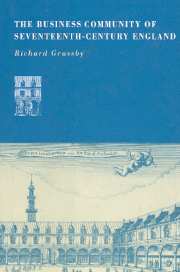Book contents
- Frontmatter
- Contents
- List of figures
- List of tables
- Preface
- List of abbreviations
- Explanatory notes
- Introduction: Questions and sources
- Part 1 Business as a career
- Part 2 Paths to fortune
- 5 The pattern of recruitment
- 6 Skills and motivation
- 7 Politics and government
- 8 The measure of success
- Part 3 Life styles
- Conclusion: Private enterprise in a pre-industrial economy
- Bibliography
- Index
5 - The pattern of recruitment
Published online by Cambridge University Press: 02 December 2009
- Frontmatter
- Contents
- List of figures
- List of tables
- Preface
- List of abbreviations
- Explanatory notes
- Introduction: Questions and sources
- Part 1 Business as a career
- Part 2 Paths to fortune
- 5 The pattern of recruitment
- 6 Skills and motivation
- 7 Politics and government
- 8 The measure of success
- Part 3 Life styles
- Conclusion: Private enterprise in a pre-industrial economy
- Bibliography
- Index
Summary
Who entered business in the seventeenth century? What were the social and geographical origins of new recruits and which sectors of the economy did they prefer? Did entry vary over time and how important was birth order? Individual indentures, sureties and references to apprenticeship occur frequently in private archives. Bindings were recorded voluntarily until 1709, when the Apprenticeship Act imposed a stamp duty on premiums and, by making enrolment compulsory, created the first national record of apprenticeship. The primary statistical sources for recruitment are therefore the apprenticeship and freedom registers of towns, guilds and Companies. The former indicate intent and the latter actual entry.
The overall pattern of recruitment is clear. A comparison of the apprenticeship and freedom registers reveals a high wastage rate. In mid-Tudor London, only 41 per cent completed their apprenticeships and became householders; given a probable mortality rate of 9 per cent during their term, the effective rate of completion was probably 65 per cent. In early Stuart London, 40 per cent of the Carpenters, 44 per cent of the Masons, 38 per cent of the Drapers, 27 per cent of the Cordwainers, 45 per cent of the Goldsmiths, 42 per cent of the Merchant Taylors, 50 per cent of the Poulterers and 41 per cent of the Stationers took their freedom. Approximately 50 per cent in Bristol, Chester, Coventry and Newcastle also fell by the wayside. In Norwich, only 17 per cent of migrants remained as freemen and only 21 per cent at Salisbury.
This does not necessarily imply a high rate of failure. Some prentices died or changed profession and cancelled their indentures.
- Type
- Chapter
- Information
- The Business Community of Seventeenth-Century England , pp. 139 - 170Publisher: Cambridge University PressPrint publication year: 1995



